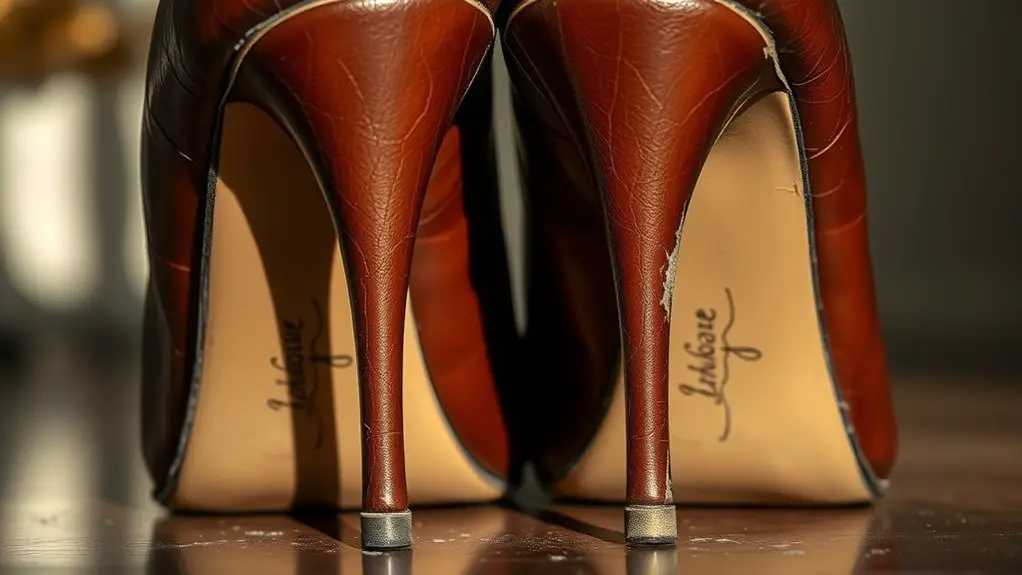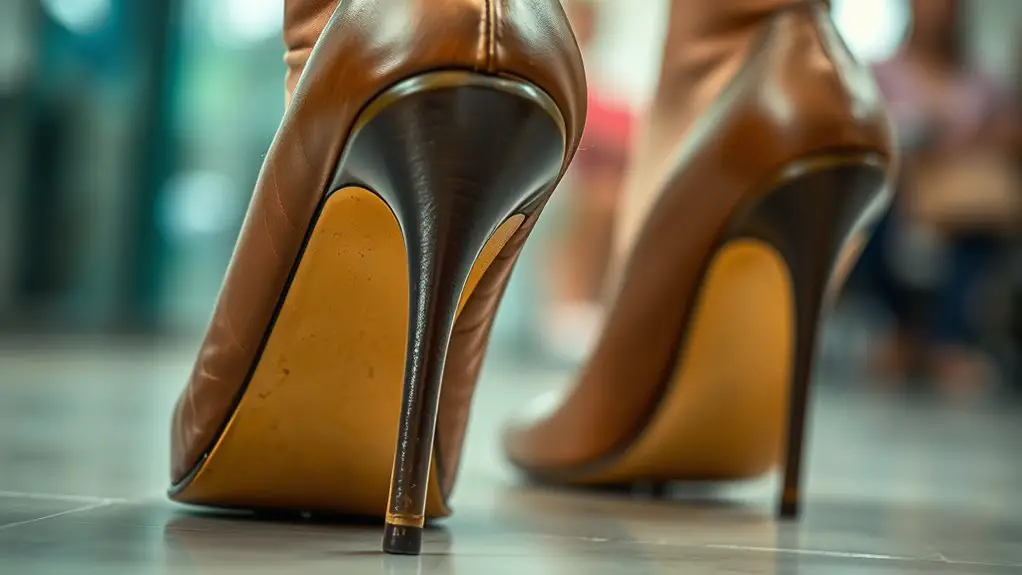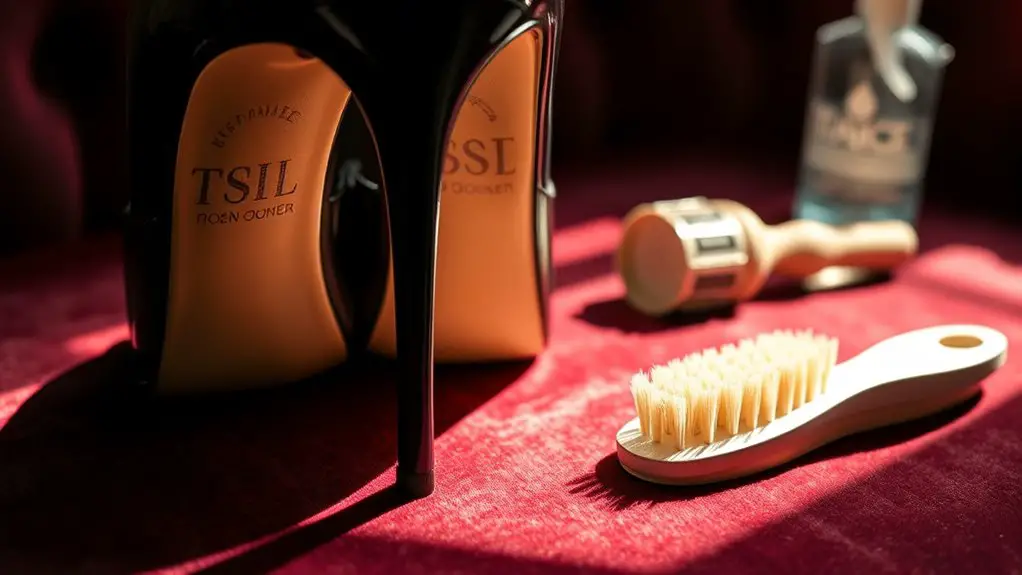Heels lose their shape over time due to a mix of factors like wear and tear, material quality, and how you care for them. Frequent use and improper storage can stretch or warp your favorites. Environmental influences like humidity and temperature changes can also play a big role. To keep your heels looking fresh, it’s essential to maintain them properly. Stick around, and you’ll discover more tips to extend their life and keep them stylish.
The Impact of Material Quality

When you invest in a pair of heels, the material quality can make all the difference in how long they maintain their shape. High-quality materials, like genuine leather or sturdy synthetics, provide better durability and resistance to wear. You’ll often find that these materials adapt to your foot over time without losing form. On the other hand, cheaper materials might look great initially but can quickly lose their structure.
Pay attention to construction techniques, too. Go for heels that feature reinforced stitching and solid soles, as these elements contribute to longevity. Heels made with good craftsmanship tend to better withstand the stresses of daily wear. Remember, investing in well-made heels isn’t just about aesthetics; it’s about ensuring they keep their shape and support you for years to come. By choosing the right material types and construction methods, you’ll give your heels a fighting chance against distortion.
The Role of Regular Wear and Tear
When you wear your favorite heels day in and day out, their shape can take a serious hit. The combination of material durability and your maintenance routine plays an essential role in how well they hold up over time. Understanding these factors can help you keep your heels looking chic and fabulous longer.
Daily Usage Impact
Although you might love the way your heels elevate your style, daily wear can take a toll on their shape and integrity. The constant foot pressure from regular use leads to noticeable wear that can compromise both comfort and aesthetics. Here are three key factors to reflect upon:
- Frequent Usage: The more you wear your heels, the more they’ll succumb to stretching and bending.
- Surface Interactions: Walking on various surfaces can impact the heel’s structure, especially if you’re on uneven ground.
- Foot Dynamics: Your unique foot shape and gait can create uneven stress, further distorting the heel over time.
Material Durability Factors
The type of materials used in your heels plays a significant role in how well they withstand daily wear and tear. High-quality material composition, like genuine leather or advanced synthetics, can greatly enhance durability. On the flip side, cheaper materials might save you money initially but often lead to quicker degradation. Understanding the manufacturing processes behind your heels can also offer insights into their longevity. For instance, heels crafted with meticulous attention to detail are likely to hold their shape better than those mass-produced without care. So, when you’re picking out your next pair, consider how the material quality and construction will impact their lifespan. Investing in well-made shoes can save you from frequent replacements down the line.
Maintenance and Care
While you might think that simply owning a pair of heels is enough, neglecting regular maintenance can lead to a rapid decline in their shape and overall appearance. To keep your heels looking fresh, consider these essential maintenance tips:
- Regular Cleaning Techniques: Wipe down your heels after each wear to remove dirt and oils that can degrade materials.
- Use Protective Products: Apply water and stain repellents to safeguard against unexpected spills and weather conditions.
- Rotate Your Shoes: Give your heels a break by alternating with other pairs. This reduces wear and allows them to regain their shape.
Improper Storage Solutions
When you toss your heels into a closet without a second thought, you’re setting them up for a quick decline. Improper stacking can lead to warped shapes, scuffed surfaces, and broken heels. Instead, consider these tips for proper storage:
| Storage Method | Pros | Cons |
|---|---|---|
| Vertical Shoe Racks | Easy access, space-saving | Limited capacity |
| Clear Boxes | Dust-free, visible | Can be costly |
| Dedicated Shelf | Organized, stylish | Requires more space |
| Dust Bags | Protects from dust | Less visibility |
| Climate-Controlled Room | Protects from humidity | Not always practical |
Also, don’t forget about climate control! Extreme temperatures can degrade materials, so store your heels in a cool, dry place for longevity. By treating your footwear with care, you’ll keep them looking fabulous for seasons to come.
The Influence of Foot Shape and Size

When it comes to heels, your foot shape and size play a pivotal role in maintaining their integrity. If you’ve ever felt discomfort from poor arch support or noticed width issues, you know how quickly style can take a backseat to fit. Understanding these factors is key to keeping your favorite pairs looking sharp and feeling great.
Arch Support Importance
Understanding the importance of arch support is crucial, especially since our feet come in a variety of shapes and sizes that can dramatically affect comfort and style in heels. Choosing the right arch support can make all the difference, particularly when considering your unique arch types and preferred support levels.
Here are three key points to keep in mind:
- Foot Shape: Your arch type—high, medium, or flat—dictates the level of support you need.
- Long-Term Comfort: Proper arch support helps distribute weight evenly, reducing fatigue during prolonged wear.
- Style Versatility: Heels with appropriate arch support maintain their shape better, allowing you to rock any look without sacrificing comfort.
Investing in the right arch support is essential for both your feet and your favorite heels.
Width and Fit Issues
Proper arch support is just one piece of the puzzle when it comes to finding the perfect heels. The width and fit of your shoes can greatly influence their longevity and comfort. If you’ve ever felt pinching or sliding, you know how essential it is to address width adjustment. Investing in brands that offer fit customization can transform your experience. Many designers now provide options for varying widths, ensuring that your heels hug your feet properly. This not only helps maintain the shoe’s structure but also prevents that dreaded loss of shape over time. Remember, a well-fitted heel isn’t just about style; it’s about the confidence and comfort that comes with knowing your shoes were tailored to your unique foot shape.
Environmental Factors and Their Effects
Although many might not realize it, environmental factors play a significant role in how heels lose their shape over time. Your favorite pair of heels can be affected by various climate conditions and moisture exposure that you might not consider at first. Here are three factors to keep an eye on:
- Humidity: Excess moisture in the air can warp materials, causing them to lose their intended shape.
- Temperature Fluctuations: Rapid changes in temperature can lead to expansion and contraction of materials, making them susceptible to deformation.
- Sunlight Exposure: Prolonged exposure to sunlight can fade colors and weaken materials, compromising structural integrity.
Maintenance Practices to Preserve Shape

Taking care of your heels is just as important as being mindful of the environmental factors that can alter their shape. To guarantee shape retention, start with proper cleaning techniques. Use a soft cloth to wipe away dirt and scuffs after each wear, and avoid harsh chemicals that can damage the material. For leather heels, a dedicated conditioner can maintain suppleness and prevent cracking.
Storing your heels properly is essential too. Consider using shoe trees or stuffing them with tissue paper to help retain their structure. Keep them in a cool, dry place, away from direct sunlight. Rotating your shoes is another smart practice; giving your favorites a break helps them last longer and preserves their shape.
Finally, be mindful of the surfaces you walk on. Steer clear of rough terrain or excessive moisture whenever possible. With a little effort, your heels can stay chic and well-shaped for longer!
When to Consider Repair or Replacement
When you start noticing signs of wear and tear on your favorite heels, it’s time to evaluate whether they need a repair or a complete replacement. Here are three key factors to contemplate:
- Extent of Damage: If your heels have minor scuffs or a loose heel, repairs might be a cost-effective solution. But if the structure is compromised, replacement options may be best.
- Repair Costs: Get quotes from local cobblers or online services. Sometimes, the cost of repair can approach or exceed the price of a new pair, especially if the heels are designer.
- Sentimental Value: If your heels hold special memories, investing in repairs may be worth it, despite the costs. It keeps that cherished pair alive and well.
Ultimately, weigh the repair costs against the potential joy of finding a new pair that aligns with current trends. Your style deserves the best!
Frequently Asked Questions
Can High Heels Be Reshaped After Losing Their Form?
Like a sculptor reviving a statue, you can breathe new life into your worn high heels. With expert reshaping techniques and professional services, your favorites can regain their elegance, ready for the runway of life again.
Do Certain Brands Hold Their Shape Better Than Others?
Absolutely, certain brands do hold their shape better than others. You’ll find that brand reputation often reflects material quality, meaning higher-end options usually maintain their form longer, ensuring you keep your style intact.
How Often Should I Replace My Heels?
Think of your heels as delicate flowers; they need care. Replace them every 6-12 months, depending on wear. Consider heel maintenance tips and footwear lifespan considerations to keep your style blooming beautifully.
Are There Specific Heel Styles That Are More Durable?
When considering heel styles, block heels often offer better durability due to their broader base, while stilettos, despite their elegance, might lack strength over time. Choosing wisely can enhance both style and longevity in your collection.
Can Weather Conditions Permanently Alter My Heel Shape?
Imagine your heels dancing in the rain. Weather effects can warp their elegance, while material impact determines durability. Humidity and heat might bend their form, leaving you with a style that’s lost its original grace.



